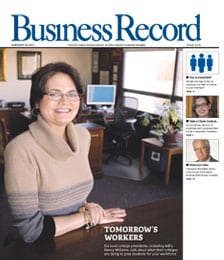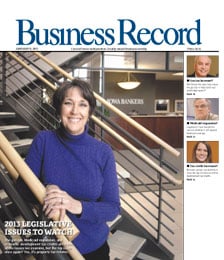Foreclosure rate soaring in Polk County

There’s no question that Kelly Michael is busy; the question is, will her workload get even heavier in 2006? Michael, a program specialist at the Polk County sheriff’s office, handles the sale of houses in foreclosure. In 2000, the office received notice of 365 foreclosure situations and sold 250 of those houses, with the rest going back to the mortgage holder. By last year, the numbers had exploded to 1,153 foreclosures and 769 homes sold by the sheriff’s department.
The trend experienced by Michael mirrors national statistics about foreclosures, and some observers think that trend is destined to continue. “Everybody predicts the foreclosure rate is going to increase,” said Linda Busick, an independent appraiser who serves on the Des Moines Area Association of Realtors board of directors and on that group’s Multiple Listings Service executive committee. “Part of it is because of low interest rates. People can afford to buy a lot more house, but when you borrow 100 percent of the price, then you get a divorce or lose your job, you have to walk away. You’ve got no equity, and you have to pay somebody to sell it.”
Those aren’t random examples; Busick said divorce and job loss are leading causes of foreclosures.
According to RealtyTrac, an online publisher of foreclosure information, foreclosures increased nationally throughout 2005, with a 25 percent jump from the first quarter to the fourth quarter. The company reported 2,104 foreclosures in Iowa, including 735 in the fourth quarter.
Another source, the Web site foreclosure.com, recently showed 216 Polk County homes in foreclosure. The majority are valued at the lower end of the market, but the list included three homes in Johnston valued at more than $300,000.
Foreclosure is much more prevalent in some other parts of the United States. Florida accounted for 14 percent of the nation’s new foreclosure cases, RealtyTrac reported, with 121,843 properties entering some stage of foreclosure. That number represents 1.67 percent of the state’s households. In second-place Colorado, 1.62 percent of the households entered some stage of foreclosure.
A recent investigation by the Columbus (Ohio) Dispatch found that 3.3 percent of Ohio home loans were in foreclosure in the first half of 2005. The newspaper said consumer advocates are calling for more regulation of aggressive mortgage brokers by the state.
“In a market where a lot of what is selling is new houses, and there’s good competition, so builders can’t raise prices, you’re letting somebody borrow 100 percent of the value plus closing costs,” Busick said.
From a lender’s point of view, “the reasons why property goes into foreclosure are out of your control when making a loan,” she said, referring to the divorce and job-loss factors. “Lenders don’t consider collateral. If you make enough money to make the payments, and your credit record is good,” you’re likely to get the loan you seek.
“There are some lenders who are on commission and have an incentive to get the deal done and get people in the house,” said Dan Vessely, president of Iowa Bankers Mortgage Corp. “That may not be in the best interest of the customer in the long term, with no room to breathe in case of a financial crisis.”
On the other side of the table, however, “it seems like most people want to buy as much house as they can possibly afford,” Vessely noted. “It seems like in the last couple of years there’s been a lot of that. I think it’s a mentality of more young people owning homes who have that no-fear factor; they don’t have the experience, and they want to buy as much home as they can possibly qualify for. Couple that with creative financing, and it’s a mixture for some failure.”
Vessely pointed out that steadily rising home prices have meant that most home purchases have been good investments. “There would be some concern if values of homes level off or slow down,” he said. “But I don’t think we’ve seen a large number of horror stories for lender or borrower. I think Iowa overall is doing better than the nation as a whole.”
Vessely said he doesn’t believe more state legislation is required to address the problem. “I believe strongly in enforcing the laws on the book about fraud; I don’t know that any new predatory lending laws by the state are the answer,” he said. “I think it would be a mistake to have a patchwork of state laws on predatory lending.”







